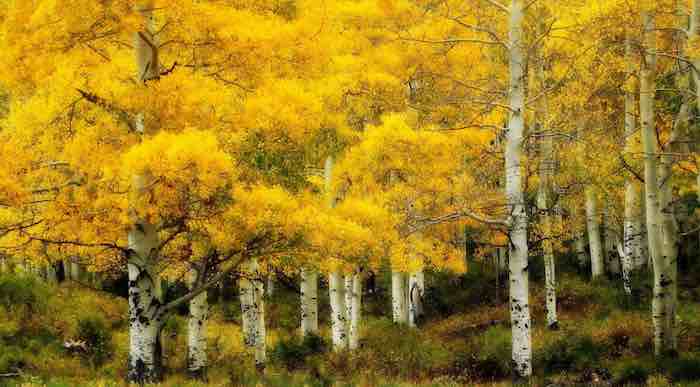
The Yellow Birch is Quebec's provincial tree. In French-Canadian it is
merisier, much to the confusion of visitors from France where
merisier means wild cherry. If that isn't enough to sow confusion, bothersome botanists and troublesome taxonomists have been at it again. What was simply and sensibly until a few years ago was
Betula lutea--in other words, Birch yellow--has been reclassified as
Betula alleghaniensis--Birch Allegheny.
In fact, Yellow Birch is centred on the Great Lakes regions eastwards through la belle province to the Maritimes with a southward spur along the cooler, moister parts of the Appalachian Mountains.
The Yellow Birch is Quebec's provincial tree
Wherever summers are not too dry and hot, this well it is north considering as a specimen landscape subject. Reaching at maturity to 25-metres, it is named for brilliant the brilliant yellow fall leaf display. Any season the bark is attractive, grey-brown peeling off in scroll-like yellow-bronze rolls.
In its natural habitat, it is associated with Eastern Hemlock (
Tsuga canadensis) but could also be placed against a background of White Cedars (
Thuja occidentalis) to pleasing effect. As with its sister species, Paper Birch (
Betula papyrifera), installation is best carried out in early spring.
Although tolerant of light shade keep away from Sugar Maples (
Acer saccharum), the roots of which emit a chemical that will stunt or even kill Yellow Birch saplings, an action known as allelopathy.
Birches closely related to Alders (
Alnus) so prefer damp conditions. Look out for Yellow Birch on moist well-drained soils in rich mixed woodland near stream banks. Under its preferred conditions, it is likely to live for 150 to 300 years, longer than most birches. Under unfavourable conditions, however, trees are liable to attack by bronze birch borer
Among the Ojibwa people of the First Nations the tree was valued for innumerable uses: bark for dwellings, lodges, canoes, storage containers, sap dishes, rice baskets, buckets, trays, dishes, even coffins. Amongst other peoples it might be utilized for medicinal properties, as a blood purifier and diuretic.
The bark and twigs smell faintly of wintergreen. At one time, oil of wintergreen was distilled from bark--now it is artificially created. In colonial times the wood was valued for used for ox yokes, sledge frames, wagon wheel hubs. Today, Yellow Birch is a valuable timber tree with hard and dense wood. If an item is described as being 'birch' it is almost certainly from this tree. It may find such mundane uses as those for spools, upholstery frames, plywood and veneers. It may be better appreciated, however, for flooring, furniture, cabinetry and gun stocks,
All in all, as Henry David Thoreau noted: "I frequently tramped eight or ten miles through the deepest snow to keep an appointment with a beech tree, or a yellow birch, or an old acquaintance among pines."
 The Yellow Birch is Quebec's provincial tree. In French-Canadian it is merisier, much to the confusion of visitors from France where merisier means wild cherry. If that isn't enough to sow confusion, bothersome botanists and troublesome taxonomists have been at it again. What was simply and sensibly until a few years ago was Betula lutea--in other words, Birch yellow--has been reclassified as Betula alleghaniensis--Birch Allegheny.
In fact, Yellow Birch is centred on the Great Lakes regions eastwards through la belle province to the Maritimes with a southward spur along the cooler, moister parts of the Appalachian Mountains.
The Yellow Birch is Quebec's provincial tree. In French-Canadian it is merisier, much to the confusion of visitors from France where merisier means wild cherry. If that isn't enough to sow confusion, bothersome botanists and troublesome taxonomists have been at it again. What was simply and sensibly until a few years ago was Betula lutea--in other words, Birch yellow--has been reclassified as Betula alleghaniensis--Birch Allegheny.
In fact, Yellow Birch is centred on the Great Lakes regions eastwards through la belle province to the Maritimes with a southward spur along the cooler, moister parts of the Appalachian Mountains.